Royal Australian Navy
| Royal Australian Navy | |
|---|---|
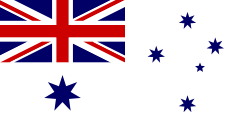 Royal Australian Naval Ensign |
|
| Active | 1911–Present |
| Country | |
| Type | Navy |
| Part of | Australian Defence Force |
| Engagements | World War I World War II Korean War Malayan Emergency Indonesian Confrontation Vietnam War Gulf War War in Afghanistan Iraq War |
| Commanders | |
| Chief of the Defence Force | Air Chief Marshal Angus Houston AC, AFC |
| Chief of Navy | Vice Admiral Russell Crane AO, CSM |
| Insignia | |
| RAN badge | 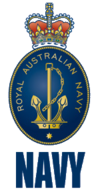 |
The Royal Australian Navy (RAN) is the naval branch of the Australian Defence Force. Following the Federation of Australia in 1901, the ships and resources of the separate colonial navies were integrated into a national force: the Commonwealth Naval Forces. Originally intended for local defence, the navy was granted the title of 'Royal Australian Navy' in 1911, and became increasingly responsible for defence of the region.
Britain's Royal Navy continued to support the RAN and provide additional blue-water defence capability in the Pacific up to the early years of World War II. Then, rapid wartime expansion saw the acquisition of large surface vessels and the building of many warships and patrol boats. In the decade following the war the RAN acquired a small number of aircraft carriers, the last of these, HMAS Melbourne paying off in 1982.
Today, the RAN is one of the largest and most sophisticated naval forces in the Pacific region, with a significant presence in the Indian Ocean and worldwide operations in support of military campaigns and peacekeeping missions.
The current Chief of Navy is Vice Admiral Russell Crane. He was appointed to this position on 4 July 2008, relieving Vice Admiral Russ Shalders.[1]
Contents |
History
The Commonwealth Naval Forces were established on 1 March 1901, two months after the federation of Australia. On 10 July 1911, King George V granted the title of 'Royal Australian Navy'.[2]
During World War I, the RAN was initially responsible for capturing many of Germany's South Pacific colonies and protecting Australian shipping from the German East Asia Squadron. Later in the war, most of the RAN's major ships operated as part of Royal Navy forces in the Mediterranean and North Seas.
During the 1920s and early 1930s, the RAN was drastically reduced in size. As international tensions increased, however, the RAN was modernised and expanded. Early in World War II, RAN ships again operated as part of the Royal Navy, many serving with distinction in the Mediterranean, the Red Sea, the West African coast, the Persian Gulf, and the Indian Ocean. Following the outbreak of the Pacific War and the virtual destruction of the Royal Navy force in Asia, the RAN operated more independently, or as part of United States Navy forces. By war's end, the RAN was the fifth-largest navy in the world.
After World War II, the size of the RAN was again reduced, but it gained new capabilities with the delivery of two aircraft carriers. The RAN saw action in many Cold War-era conflicts in the Asia-Pacific region and operated alongside the Royal Navy and United States Navy off Korea, Malaysia and Vietnam. Since the end of the Cold War, the RAN has been part of Coalition forces in the Persian Gulf and Indian Ocean and has become a critical element in Australian operations in East Timor and the Solomon Islands.
The Royal Australian Navy celebrated its 75th Anniversary in 1986. These celebrations were highlighted by a mass visitation of naval ships and crews from various foreign navies. Some controversy ensued when the Rear Admiral in charge of organising these celebrations (and who also went on to become Governor of New South Wales) Rear Admiral Sir David Martin admitted on live television that "doubtless, some of the vessels will be carrying nuclear weapons" (delivered live to air on "Today" TCN 9 Sydney).
Battle honours
New RAN Battle Honours were approved by the Governor General of Australia and published to correspond with the 109th anniversary of the RAN on 1 March 2010.[3][4] These include: "Iraq 2003", "Persian Gulf 2001-2003", and "East Timor 1999-2000". The listing includes all RAN and colonial ships with honours, dating from the Victorian Naval Forces sloop HMVS Victoria (honoured: "New Zealand 1860-61").
RAN today
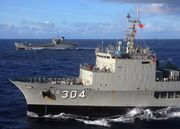
Command structure
The RAN is commanded through Naval Headquarters (NHQ) in Canberra. The professional head is the Chief of Navy (CN), who holds the rank of Vice-Admiral. NHQ is responsible for implementing policy decisions handed down from the Department of Defence and for overseeing tactical and operational issues that are the purview of the subordinate commands.
Beneath NHQ are two subordinate commands:
- Fleet Command - the administrative element responsible for the RAN's operational seagoing forces, as well as the planning and implementation of all of Australia's maritime operations. Its commander holds the rank of Rear Admiral; previously, this post was Flag Officer Commanding HM's Australian Fleet (FOCAF), created in 1911,[5] but the title was changed in 1988 to the Maritime Commander Australia. On 1 February 2007, the title changed again, becoming Commander Australian Fleet.[6] The nominated at-sea commander is Commodore Flotillas (COMFLOT), a one-star deployable task group commander.
- Systems Command - the administrative element overseeing the RAN's training, engineering and logistical support needs. Instituted in 2000, the Systems Commander was appointed at the rank of Commodore; in June 2008, the position was upgraded to the rank of Rear Admiral.
Beneath the subordinate commands are seven "Force Element Groups" (FEGs) that form the bulk of the RAN's operational capability. Their respective commanders hold the rank of either Commodore or Captain as indicated below:
- Surface Combatants FEG (COMAUSNAVSURFGRP - Commodore)
- Amphibious and Afloat Support FEG (COMAUSNAVAASGRP - Captain)
- Aviation FEG (COMAUSNAVAIRGRP - Commodore)
- Submarine FEG (COMAUSNAVSUBGRP - Commodore)
- Mine Clearance Diving FEG (COMAUSNAVMCDGRP - Captain)
- Patrol Boat FEG (COMAUSNAVPBGRP - Captain)
- Hydrographic, Meteorological and Oceangraphic FEG (COMAUSNAVHYDROGRP - Commodore)
Fleet
As of 2009, the RAN fleet consisted of 51 vessels, including frigates, submarines, patrol boats and auxiliary ships. The modern RAN is tasked with defending Australian waters and undertaking wider deployments. Current RAN deployments include: contributions to the multinational force in Iraq; support for the UN mission in East Timor and a "regional assistance mission" with New Zealand in the Solomon Islands.
The RAN has two primary bases for its fleet:
- Fleet Base East, located at HMAS Kuttabul near Sydney; and
- Fleet Base West, located at HMAS Stirling near Perth.
In addition, three other ports are home to the majority of the RAN's minor war vessels:
Current ships
The RAN currently operates 54 commissioned vessels, made up of nine ship classes, and three individual ships.
| Image | Class/Name | Type | Number | Entered service | Details |
|---|---|---|---|---|---|
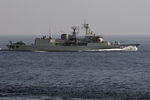 |
Anzac class | Frigate | 8 | 1996 | Anti-submarine and anti-aircraft frigate with 1 S-70B-2 Seahawk helicopter. Two more were built for the Royal New Zealand Navy |
.jpg) |
Adelaide class | Frigate | 4 | 1985 | Anti-submarine and anti-aircraft frigate with 2 Sikorsky S-70B-2 Seahawk helicopters. Two more ships were decommissioned in 2005 and 2008. |
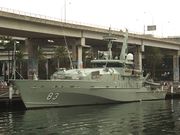 |
Armidale class | Patrol boat | 14 | 2005 | Coastal defence, maritime border, and fishery protection |
 |
Huon class | Minehunter | 6 | 1997 | Minehunting |
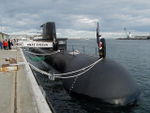 |
Collins class | Submarine | 6 | 2000 | Anti-shipping, intelligence collection. Diesel-electric powered |
 |
Kanimbla class | Amphibious transport | 2 | 1994 | Troop and helicopter transport (Westland Sea King and S-70A-9 Black Hawk). Modified from the United States Navy's Newport class tank landing ships |
 |
Balikpapan class | Landing Craft Heavy | 6 | 1971 | Light lift amphibious transport. Two more were transferred to the fledgling Papua New Guinea Defence Force in 1975. |
 |
Leeuwin class | Survey ship | 2 | 2000 | Hydrographic survey |
|
|
Paluma class | Survey launch | 4 | 1989 | Hydrographic survey |
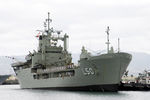 |
HMAS Tobruk | Landing Ship Heavy | – | 1989 | Heavy sealift and transport. Modified Round Table class. |
 |
HMAS Success | Replenishment ship | – | 1986 | Replenishment at sea and afloat support. Modified Durance class. |
 |
HMAS Sirius | Replenishment ship | – | 2006 | Replenishment at sea and afloat support. Modified commercial tanker. |
Fleet Air Arm
The Fleet Air Arm provides the RAN's aviation capability. At present, it is an entirely helicopter-based force, with a total of three squadrons. Most of the RAN's larger ships are capable of operating helicopters; frigates typically carry Sikorsky S-70B Seahawks, while support ships carry Westland Sea King Mk 50 aircraft during operational deployments. The Fleet Air Arm and its associated support are under the direction of the Navy Aviation Force. Both the NAF and Fleet Air Arm are located at HMAS Albatross in New South Wales.
Clearance Diving Teams
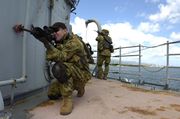
The RAN has two Clearance Diving Teams that serve as parent units for naval clearance divers:
- Clearance Diving Team 1 (AUSCDT ONE), based at HMAS Waterhen in New South Wales; and
- Clearance Diving Team 4 (AUSCDT FOUR), based at HMAS Stirling in Western Australia.
When RAN personnel are sent into combat, Clearance Diving Team Three (AUSCDT THREE) is formed.
The CDTs have two primary roles:
- Mine counter-measures (MCM) and explosive ordnance disposal (EOD); and
- Maritime tactical operations.
Future
 CGI impression of the planned Australian Air Warfare Destroyer |
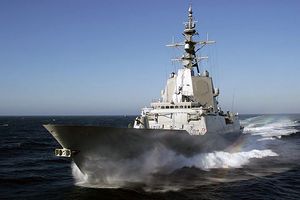 Álvaro de Bazán class frigate, basis for the Sea 4000 Project |
 Women serve in the RAN in combat roles and at sea |
There are currently several major projects underway that will see upgrades to RAN capabilities:
- Project AIR 9000 Phase 2 is a project to replace the RAN's Sea King helicopters with twenty-four Naval Combat Helicopters (NH90 NFH or MH-60R). The project is also providing twenty-two helicopters to the Australian Army.
- Project JP 2048 Phases 4A and 4B is a project to build two Canberra-class Landing Helicopter Dock (LHD) amphibious ships (based on the Spanish Buque de Proyección Estratégica), each displacing 27,000 t. These will be the largest RAN warships ever commissioned and will replace HMAS Tobruk and a Kanimbla class vessel.
- Project JP 2048 Phase 3 will provide six Heavy Landing Craft to replace the RAN's Balikpapan-class vessels.
- Project SEA 1390 Phase 2.1 will see the upgrading of four Adelaide-class guided missile frigates with enhanced weapons and electronics.
- Project SEA 1429 will upgrade the Collins-class submarines with state-of-the-art heavyweight torpedoes.
- Project SEA 1439 Phase 4A will equip the Collins-class submarines with a new tactical combat system.
- Project SEA 1654 Phase 3 is a project to acquire a Sea Logistic Support and Replenishment Support vessel to replace the supply ship HMAS Success.
- Project SEA 4000, under which the RAN will acquire three Hobart-class Air Warfare Destroyers, with the possibility of a fourth, built around the United States Navy Aegis air and surface combat management system. It was announced in June 2007 that the vessels will be based on the Spanish Álvaro de Bazán-class frigate.[7][8]
The RAN needs 2,000 recruits, including 700 apprentices,[9] to crew the next generation of warships, such as air warfare destroyers, which enter service next decade.
Future procurement plans include:
- twelve Future Submarines, under Project SEA 1000, to replace the Collins-class (up to 4,000 tons, equipped with cruise missiles and minisubs);
- eight Future Frigates to replace the Anzac-class frigates (possibly up to 7,000 tons and equipped with cruise missiles);
- twenty Offshore Combatant Vessels, under Project SEA 1180, to replace the Armidale, Huon, Leeuwin, and Paluma classes (up to 2000 tons); and
- one Strategic Sealift Vessel to replace the second Kanimbla-class ship (~15,000 tons, similar to the Spanish Galicia-class landing platform dock).[10]
Current operations
The RAN currently has forces deployed on three major operations:
- Operation Anode - Australia's contribution to the Regional Assistance Mission in the Solomon Islands.
- Operation Slipper - Australia's commitment to the International Coalition forces in Afghanistan and against Terrorism (ICAT). The RAN's contribution is normally one ship in the Persian Gulf.
- Operation Resolute - the ADF's contribution to patrolling Australia's Exclusive Economic Zone
Full details of current Australian Navy operations can be found at http://www.navy.gov.au/operations/
Ranks and Uniforms
The uniforms of the Royal Australian Navy are very similar in cut, colour and insignia to their British Royal Navy forerunners. However, beginning with the Second World War all RAN personnel began wearing shoulder flashes reading Australia, a practice continuing today. These are cloth arcs at shoulder height on uniforms, metallic gold on officers' shoulder boards, and embroidered on shoulder slip-ons.
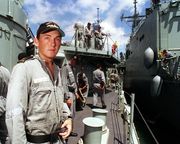
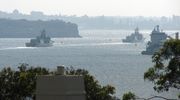
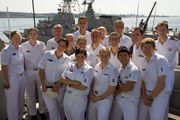
Officer ranks
| CODE | ||||
|---|---|---|---|---|
| Flag Officers | ||||
| O-11 | Admiral of the Fleet | |||
| O-10 | Admiral | |||
| O-9 | Vice Admiral | |||
| O-8 | Rear Admiral | |||
| O-7 | Commodore | |||
| Senior Officers | ||||
| O-6 | Captain | |||
| O-5 | Commander and Navy Chaplain | |||
| Junior Officers | ||||
| O-4 | Lieutenant Commander | |||
| O-3 | Lieutenant | |||
| O-2 | Sub Lieutenant | |||
| O-1 | Acting Sub Lieutenant | |||
| S-1 | Midshipman | |||
Non-commissioned ranks
| CODE | ||||
|---|---|---|---|---|
| Warrant Officers | ||||
| E-9 | Warrant Officer of the Navy | |||
| E-9 | Warrant Officer | |||
| Senior Non-commissioned Officers | ||||
| E-8 | Chief Petty Officer | |||
| E-7 | - | |||
| E-6 | Petty Officer | |||
| Junior Non-commissioned Officers | ||||
| E-5 | Leading Seaman | |||
| E-4 | - | |||
| Enlisted | ||||
| E-3 | Able Seaman | |||
| E-2 | Seaman | |||
Chaplains
Royal Australian Navy (RAN) chaplains are commissioned officers and wear the uniform of a RAN officer. Like chaplains in the Royal Navy (RN) they do not wear a rank. Rather they wear the same cross and anchor emblem worn by RN chaplains on their shoulder rank slides and do not have gold braided rings or executive loops on their winter coat sleeve or summer shoulder boards. Like other chaplains in the Australian Defence Force (ADF), Navy chaplains have five divisions of seniority. Australian Navy chaplains are accorded a certain rank for protocol and ceremonial occasions and for saluting purposes. Division 1, 2 and 3 Australian Navy chaplains are accorded the rank and status as Commander (equivalent of Lieutenant Colonel in the Australian Army). Division 4 Australian Navy chaplains are accorded the rank and status of Captain (equivalent of Colonel). Division 5 Australian Navy chaplains are "Principal Chaplains," and these three chaplains, representing the three major Christian denominations: Catholic, Anglican and Protestant, are accorded the rank and status of Commodore (equivalent of Brigadier). Principal Chaplains' uniforms do not differ from other Navy chaplains however they do wear gold braid or "scrambled egg" on the peak of their caps. The title "Padre" for chaplains is less common in the Royal Australian Navy, than in the Australian Army, although it is known to be used by many sailors and some Navy chaplains in preference to the more formal title of "Chaplain", or other formal forms of address towards an officer such as "Sir."
See also
- Australian White Ensign
- Royal Australian Navy School of Underwater Medicine
References
- ↑ Ministerial media release Defence.gov.au accessed 14 June 2008
- ↑ "The R.A.N. - A Brief History". Royal Australian Navy. http://www.navy.gov.au/The_R.A.N._-_A_Brief_History. Retrieved 2008-09-19.
- ↑ "Navy Marks 109th Birthday With Historic Changes To Battle Honours". Royal Australian Navy. 1 March 2010. http://www.navy.gov.au/Navy_Marks_109th_Birthday_With_Historic_Changes_To_Battle_Honours. Retrieved 14 March 2010.
- ↑ "Royal Australian Navy Ship/Unit Battle Honours". Royal Australian Navy. 1 March 2010. http://www.navy.gov.au/w/images/Units_entitlement_list.pdf. Retrieved 14 March 2010.
- ↑ C L Cumberlege
- ↑ Top Stories
- ↑ Commonwealth of Australia (2009). Defence White Paper 2009. Commonwealth of Australia. pp. 70-74. ISBN 9780642297020. http://www.defence.gov.au/whitepaper/docs/defence_white_paper_2009.pdf. Retrieved 2010-09-01.
- ↑ "Defence Materiel Organisation". DMO Projects. Commonwealth of Australia. http://www.defence.gov.au/dmo/lsp/index.cfm. Retrieved 2010-09-01.
- ↑ Defence White Paper 2009. pp. 114.
- ↑ Defence White Paper 2009. pp. 70-74.
External links
- Royal Australian Navy home page
- 'Virtual Fleet' - on-line computer based 'tour' of ships and aircraft
- Maritimequest Royal Australian Navy photo gallery
- Official Biographies:
- Royal and Dominion Navies in World War II, Campaigns, Battles, Warship losses
- Royal and Dominion Navies, Victoria Cross at Sea, 1940-45
|
||||||||||||||
|
||||||||||||||||||